 Norway Day 3.. we went museuming today... it was cool and grey outside, threatened with rain although it never quite eventuated.
Norway Day 3.. we went museuming today... it was cool and grey outside, threatened with rain although it never quite eventuated.Tomorrow it's down to work, so this is probably the last post from Norway...
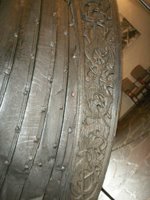
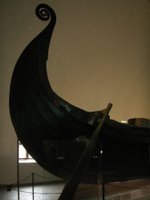
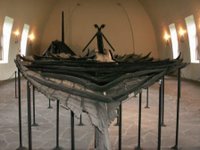 The first shots today are from the Viking ship museum, which has the best preserved viking ships in the world. The ships were found in three large burial mounds in Eastern Norway. The Oseberg ship, which is the first pictured, had been a sailing vessel and was reused as a burial ship for a prominent woman who died in 834 AD. The second ship pictured here on the left is the Tune ship, and is in the condition it was found in in 1867.
The first shots today are from the Viking ship museum, which has the best preserved viking ships in the world. The ships were found in three large burial mounds in Eastern Norway. The Oseberg ship, which is the first pictured, had been a sailing vessel and was reused as a burial ship for a prominent woman who died in 834 AD. The second ship pictured here on the left is the Tune ship, and is in the condition it was found in in 1867. 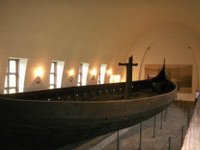 The third is the Gokstad ship, which was built around 890 AD and was used in the burial of a powerful chieftan.
The third is the Gokstad ship, which was built around 890 AD and was used in the burial of a powerful chieftan.The only Viking Age wagon was found at the burial site in Oseberg. It's believed that women of high social standing travelled to their burial in such wagons, and they appear to be purely ceremonial, as the front axle is attached to the chassis, preventing the wagon from turning. The wagon is inticately carved, with scenes that are probably llustrations of legends.
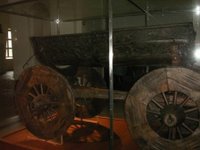
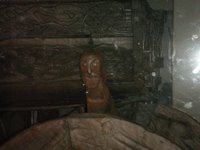
After the Viking museum we headed down to the Fram museum, to see ships from a later period of Norwegian history.
The Fram museum tells the history of polar exploration, north and south pole.
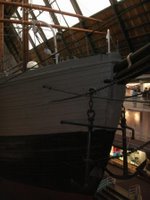 The polar ship Fram is the strongest vessel in the world, and the one sea-going vessel that has been the furthest north and south.
The polar ship Fram is the strongest vessel in the world, and the one sea-going vessel that has been the furthest north and south. 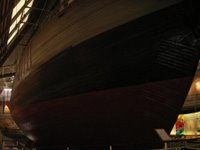 Fram was designed to survive the pressure of the freezing ice in the polar oceans, because of its shape that allowed the ice to push the ship up, allowing it to 'float' on top of the ice. Fram was used by Nansen and Sverdrup to explore the North Pole, and Amundsen to reach the South Pole. It's hard to get perspective, as it's HUGE, but the picture on the left shows the reinforcing on the edge of the hull to allow it to withstand the conditions. Inside there's a display with lots and lots of seal skin clothes, polar bear rugs and other artefacts from the expeditions... like this ...
Fram was designed to survive the pressure of the freezing ice in the polar oceans, because of its shape that allowed the ice to push the ship up, allowing it to 'float' on top of the ice. Fram was used by Nansen and Sverdrup to explore the North Pole, and Amundsen to reach the South Pole. It's hard to get perspective, as it's HUGE, but the picture on the left shows the reinforcing on the edge of the hull to allow it to withstand the conditions. Inside there's a display with lots and lots of seal skin clothes, polar bear rugs and other artefacts from the expeditions... like this ...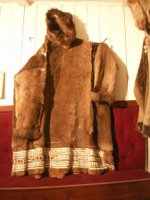 Last stop for the day was the Historical Museum, part of the University of Oslo as was the Viking Ship Museum.
Last stop for the day was the Historical Museum, part of the University of Oslo as was the Viking Ship Museum.On display here is a collection of Norwegian antiquities from the Ice Age to the coming of Christianity and ethnographic collections showing artefacts from the indigenous people of the Arctic regions.
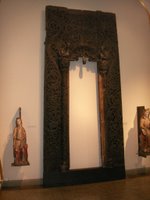
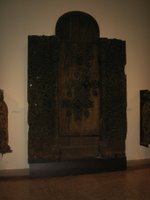 On the left and right are two Viking doors, each huge and most spectacularly carved. Below is the front and back of the most glorious ceremonal robe I have ever seen. I suppose it's Sami, as it was in that general area, but I could be wrong - all of the signage was in Norwegian!
On the left and right are two Viking doors, each huge and most spectacularly carved. Below is the front and back of the most glorious ceremonal robe I have ever seen. I suppose it's Sami, as it was in that general area, but I could be wrong - all of the signage was in Norwegian!It's made of animal skins and there are things hanging off t everywhere.. I just think it's beautiful, and so is the headdress pictured near it. If you can see, there is a picture of someone wearing the robe in the background of the picture taken from the front.
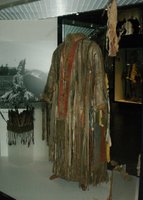

No comments:
Post a Comment